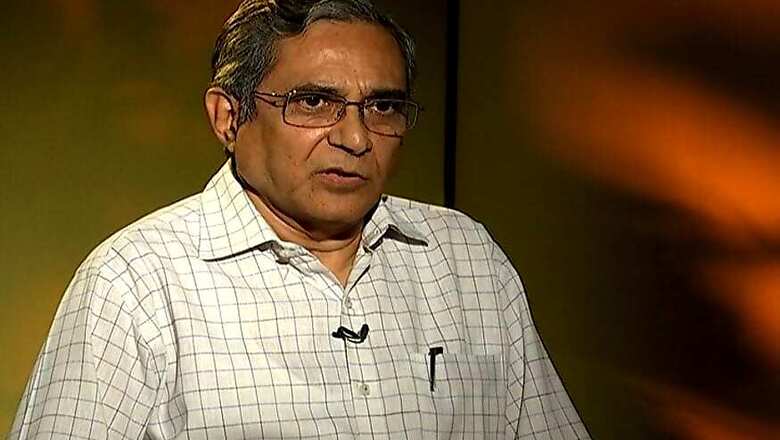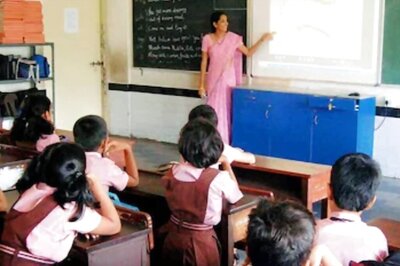
views
As India is set to see launch of goods and services tax (GST), which is being projected as the biggest tax reform since Independence, GST Network (GSTN) chairman Navin Kumar tells News18’s Kamala Sripada that while he and his team are stressed, they are confident of a smooth launch. Commenting on fears around data safety, Kumar says no shareholder will have access to the database. Kumar also says that GSTN software is foolproof and ready to serve taxpayers across the country. Edited excerpts:
India is set for GST launch on July 1 and all eyes are on the IT system. Are you anxious about it?
We started in November 2015 and have been working on IT infra for more than 18 months. Thanks to the preparations we have made during this period, we are in a position to handle all the requirements. Yes, we are very stressed, but we are confident.
In the recent past, you said that GSTN did not get enough time for dry runs. How confident are you of a glitch-free rollout?
When you build a system like this, a large system, with huge requirements, you need to make all kinds of preparations… what kind of sizing needs to be done, what is the load that the system has to handle, etc. Therefore, you do all the planning and design the system to meet those requirements.
We began in November 2015 when the GST Constitution Amendment Bill was still in Parliament. When they awarded the work to our IT partner, we did not know where to begin and how to begin. So we went to the empowered committee of the state finance ministers and we suggested that we should be allowed to start work on the software, because software development takes time. That was permitted and we were told to hold back on the hardware. That’s how we began. The committee also allowed us to work on the approved business processes and draft business processes.
The law came in May 2016 so they made changes in the software accordingly. Then the law was revised and model GST law came in November 2016. The revised rules came in December. So by the time the central government enacted the legislation our software was largely done. Therefore, the changes that came after the law and the rules, we have incorporated them. We have no problem. Yes, the time was very short but we conducted all the tests.
When the code was written, unit testing was done. Once the code was ready, it was put in the whole system and the system integration testing was done. Then, before Infosys handed over the software to us, they did what’s known as release testing. When it came to us, we did user acceptance testing, we have a team of 40 testers along with 10 officers.
We rigorously completed all the tests and we have also done a dry run. In May, with the software that was available to us at that time, we did the dry run with about 3000 taxpayers. We used that feedback to improve our system.
You are talking about the May dry run. Is a dry run with just 3000 people sufficient for a software which is to be used by millions of taxpayers? What was the feedback from users?
Basic idea behind such a dry run is to see how comfortable the users are with the software. So we did that and we had good feedback. One important thing that came to our light was we had given an offline utility to the taxpayers where they can put their transactions data, their invoice-level data at their convenience, and then that tool imports the data and uploads it to our system.
Initially, some of the users said it was not opening on their systems. We found the reason was that they had very old computers. And our software ran on 64 bit computers and above. We decided to make changes in the software so that it can be used on 32 bit computers also.
Similarly, there was some confusion around formatting of calendar. We made all the necessary changes.
In GSTN, government holds 49 per cent stake, while private players hold 51 per cent. Many people have raised concerns around data security. How would you respond to that?
These are two different things. Shareholding in a company doesn’t entitle any shareholder to access to the data. Data can be accessed only by persons authorized by law. The tax officers by law are authorized to access data and the taxpayers can access their own data.
Are you saying that no private player will have any access to database?
None of the private players can access the data. Apart from authorized persons as per law, no shareholder can access the data by the virtue of being a shareholder. Therefore, it is not a problem at all.
The other aspect is security of the data. The data that we are getting is very sensitive as it has details of business transactions. Therefore, the data has to be protected. We have made full arrangements for that. In fact, this thoughts has been uppermost in our minds from the stage of drafting of the RFP. In RFP itself we had put a special security of the system and we specified very clearly what all the IT partner was required to do to ensure security.
To tell you briefly, our system will be ISO 27001 certified, which is the best known standard for information security management system. So we are going to do that and we have a layered security structure which provides security at various levels. Starting from physical security, then you have network security, then you have at the application level, at the data level, at the software writing level also, where we follow secure coding practices, so we have done all that.
On top of that, we have set up a security operations centre which will run 24x7x365. This centre is keeping an eye on the entire traffic to the GST system that we are managing. If there are any suspicious activities, they would raise an alarm and we would take action. So I want to assure the taxpayers and the people of India that the data which is coming to the GST system is fully secure and we are using the best possible tools and software available in the world.
You are confident that this is going to be a glitch-free launch. But if a user faces problem, what is the mechanism to register complaint?
Yes, when you have a large system and there are so many people working on it, you may come across some problems. These problems may be generated because of the computer system you are using, or the software that you have on your computer, or because of the connectivity. Various kinds of things could happen. To take care of such problems of the taxpayers, who are using our portal, we have set up a 400-seat helpdesk, which will run throughout the year. Anyone can call 1204888999 and they will help.
One special thing that we have done is that if you complain as a taxpayer, the agent at the helpdesk will tell you what to do. If you are not able to understand and do troubleshooting, then if you permit, our agent can access your computer. He will be able to see what is there on the screen and guide you to solution. He will not be able to make changes himself, but will guide you, provided you permit him to do that. This facility will help users in resolving problems.
When you say that somebody can access your account, one immediately gets concerned about privacy. How will you ensure that no agent ever misuses this facility?
The agent will be able to view your screen only when you permit him/her. It can only happen as long as you are on the screen. Once the task is over, our agent will be logged out. The user will also have access to a button to log out the agent.
While big businesses have made requisite preparations for GST launch, small businesses and start-ups are nervous and concerned if compliance and legal costs will go up under GST regime.
Let me tell you about the process and compliance requirements. Let us first understand that if you are doing business under GST, you have to be registered. If you are an existing taxpayer, you would have been migrated. Otherwise, you have to register, which I have already explained. Once you register, you have to periodically submit tax payments. Now, under the existing systems also, of the existing taxes, returns are filed by the taxpayers. SMEs are already filing returns. They know how to do it and let me also tell you that over the past decade, thanks to a mission mode operated by the government of India, where a lot of financial assistance was given to the states, all states have computerised their commercial tax operations and in all states the taxpayers are required to go for e-filing. Therefore, today we are in a happy situation where the taxpayers know how to e-file. It is not a challenge.
Under GST, if you are a small taxpayer with a turnover of less than Rs 75 lakh, you can opt for composition scheme. If you opt for composition scheme, you don’t collect tax. You pay only a turnover tax of 1% or 2% or 5%, depending on what kind of taxpayer you are. And these people, i.e. composition dealers, are required to submit the return once in 3 months and they only have to mention their turnover and tax payable on it at the rate of 1% or 2% or 5% It is as simple as that.
Supposing you are an SME, but you don’t opt for composition scheme, supposing you have a turnover of Rs 40 lakh, the issue with composition scheme is that if you opt for it, you can’t pass credit to the buyer. So the businesses will not like to buy from you. Therefore, if you decide not to go for composition, and you have an SME, then you have to upload you invoice data to the GST portal to facilitate this offline utility. We designed this specifically keeping in mind SMEs because that will allow us to have this on their computer and at their convenience put their invoices data over there. Suppose you have 50 thousand invoices per month, our portal you can come and punch the data. If you have 50 thousand, then you can’t do that. If you use our offline utility, which can handle 19,000 invoices at a time, and uploading of this 19,000 invoices takes half a minute, depending on the speed of your connection.
So please do it every week. It will be as simple as that. In GST, you don’t have to file your sales data, purchase data, your tax liability. You have to give only sales data, which is invoices, our system puts it in the purchase returns of the buyers, our system prepares all the returns, our system calculates and tells what is your tax liability, then you just make a tax payment and you are done. So it is very simple and no one needs to have any problems.
You are saying in terms of paperwork there is no reason to worry for small businesses?
Not at all, they will be doing less paper work than before.




















Comments
0 comment